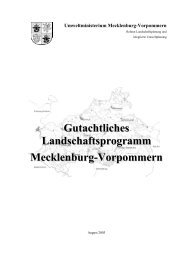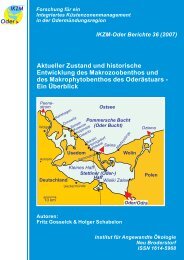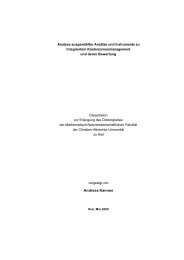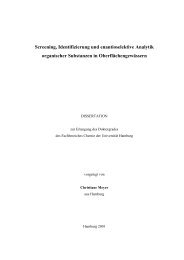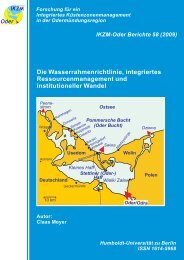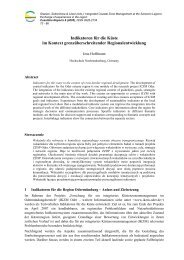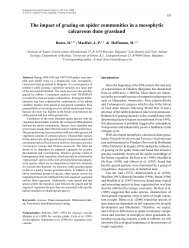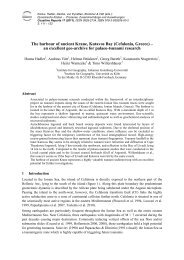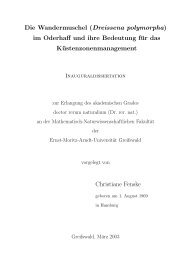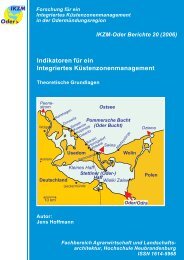Floristic composition and vegetation ecology of the Malindi Bay ...
Floristic composition and vegetation ecology of the Malindi Bay ...
Floristic composition and vegetation ecology of the Malindi Bay ...
Create successful ePaper yourself
Turn your PDF publications into a flip-book with our unique Google optimized e-Paper software.
Journal <strong>of</strong> Coastal Conservation 9: 97-112, 2003<br />
© EUCC; Opulus Press Uppsala.<br />
- <strong>Floristic</strong> <strong>composition</strong> <strong>and</strong> <strong>vegetation</strong> <strong>ecology</strong> <strong>of</strong> <strong>the</strong> <strong>Malindi</strong> <strong>Bay</strong> coastal dune field, Kenya - 97<br />
<strong>Floristic</strong> <strong>composition</strong> <strong>and</strong> <strong>vegetation</strong> <strong>ecology</strong><br />
<strong>of</strong> <strong>the</strong> <strong>Malindi</strong> <strong>Bay</strong> coastal dune field, Kenya<br />
Abuodha, J.O.Z. 1* ; Musila, W.M. 2 & van der Hagen, H. 3<br />
1 Department <strong>of</strong> Environmental Studies, Maseno University, P.O. Box 333, Maseno, Kenya;<br />
2 Plant Conservation Program, National Museums <strong>of</strong> Kenya, P.O. Box 45166, Nairobi, Kenya;<br />
3 Duinwaterbedrijf Zuid-Holl<strong>and</strong>, Cantineweg 19A, 2224 XP Katwijk aan Zee, The Ne<strong>the</strong>rl<strong>and</strong>s;<br />
Corresponding author; E-mail joabuodha@yahoo.com; Fax +254057351221<br />
Abstract. A short outline is given <strong>of</strong> <strong>the</strong> floristic <strong>composition</strong>,<br />
structure <strong>and</strong> distribution <strong>of</strong> coastal dune <strong>vegetation</strong> found at<br />
<strong>Malindi</strong> <strong>Bay</strong>, Kenya. The area was studied by air photo interpretation<br />
<strong>and</strong> field sampling to determine <strong>the</strong> relationship <strong>of</strong><br />
plants to aeolian features. TWINSPAN classification was<br />
used to distinguish geomorphological units on <strong>the</strong> basis <strong>of</strong><br />
<strong>the</strong>ir species <strong>composition</strong>.<br />
In this paper, an inventory <strong>and</strong> first quantitative analysis <strong>of</strong><br />
<strong>vegetation</strong> distribution is presented. We identified 174 plant<br />
species from 62 families in <strong>the</strong> s<strong>and</strong> dunes <strong>and</strong> several plant<br />
communities are distinguished based on <strong>the</strong> species content<br />
<strong>and</strong> <strong>the</strong> connection with morphological units. Papilionaceae<br />
with 18 species <strong>and</strong> Poaceae with 17 species were <strong>the</strong> most<br />
represented families. A distinct zonal distribution <strong>of</strong> <strong>the</strong> plant<br />
communities was found.<br />
The most important plant species are <strong>the</strong> pioneer <strong>vegetation</strong><br />
consisting <strong>of</strong> Halopyrum mucronatum, Ipomoea pescaprae<br />
<strong>and</strong> Scaevola plumieri. The woody shrub species which<br />
have colonized <strong>the</strong> established primary dunes <strong>and</strong> hummock<br />
dunes are Cordia somaliensis, Pluchea discoridis, Tephrosia<br />
purpurea (dunensis). Succulent herbs were identified in <strong>the</strong><br />
dune slacks <strong>and</strong> salt marsh that are moist <strong>and</strong> damp environments.<br />
Keywords: Classification; Coastal dune; Ecosystem; Geomorphological<br />
unit; Geomorphology; Monsoon; Structure;<br />
Tropical.<br />
Introduction<br />
Interest in <strong>the</strong> factors that control <strong>the</strong> stability <strong>and</strong><br />
instability <strong>of</strong> <strong>the</strong> natural dune ecosystem has grown as<br />
<strong>the</strong> dem<strong>and</strong>s for <strong>the</strong>ir recreational <strong>and</strong> industrial usage<br />
have increased <strong>and</strong> as <strong>the</strong> value <strong>of</strong> dunes as natural<br />
coastal defence has been recognized. The dynamic dune<br />
management procedure requires that as much as possible<br />
<strong>of</strong> <strong>the</strong>ir natural aes<strong>the</strong>tics are retained during coastal<br />
development <strong>and</strong> management. However, when coastal<br />
infrastructure is threatened by transgressive s<strong>and</strong> sheets,<br />
<strong>the</strong> most effective method <strong>of</strong> arresting such dune mobility<br />
is <strong>the</strong> use <strong>of</strong> s<strong>and</strong> binding <strong>vegetation</strong> because littoral<br />
<strong>vegetation</strong> is capable <strong>of</strong> trapping s<strong>and</strong> close to <strong>the</strong> beach.<br />
Exceptions occur where <strong>the</strong> rate <strong>of</strong> aeolian s<strong>and</strong><br />
transport from <strong>the</strong> beach is so high that vertical growth<br />
<strong>of</strong> <strong>vegetation</strong> is unable to keep pace, or where <strong>vegetation</strong><br />
vigour is inhibited for o<strong>the</strong>r biological or environmental<br />
reasons. This is normally <strong>the</strong> case where <strong>vegetation</strong> is<br />
disturbed or destroyed through human settlement, trampling,<br />
farming, overgrazing, collection <strong>of</strong> fuelwood or<br />
construction <strong>of</strong> tourist amenities as is happening in <strong>the</strong><br />
study area. Disturbance <strong>of</strong> <strong>vegetation</strong> cover caused <strong>the</strong><br />
reactivation <strong>of</strong> previously stabilized dunes.<br />
The area under investigation is a distinct morphodynamic<br />
system with well defined boundaries, representing<br />
<strong>the</strong> littoral sediment cell extending from <strong>Malindi</strong><br />
to Mambrui. It gets more distinct from <strong>the</strong> extremities in<br />
north <strong>and</strong> south, towards <strong>the</strong> Sabaki river in <strong>the</strong> middle<br />
<strong>of</strong> <strong>the</strong> stretch.<br />
The aeolian sediments forming <strong>the</strong> current foredune<br />
system <strong>and</strong> drifting s<strong>and</strong>s are derived from <strong>the</strong> beach,<br />
which is supplied by <strong>the</strong> Sabaki river. However, <strong>the</strong><br />
mobile s<strong>and</strong> climbing over <strong>the</strong> dune ridges is a combination<br />
<strong>of</strong> beach s<strong>and</strong> <strong>and</strong> s<strong>and</strong> resulting from erosion <strong>of</strong><br />
older stabilized dunes (Abuodha 2000).<br />
The literature on coastal dune <strong>vegetation</strong> in <strong>the</strong><br />
tropics is ra<strong>the</strong>r scanty <strong>and</strong> it is <strong>the</strong>refore envisaged that<br />
<strong>the</strong> present data set will instigate more investigations into<br />
<strong>the</strong> ecological status <strong>of</strong> <strong>the</strong> present dunes. In addition,
98 Abuodha, J.O.Z. & van der Hagen, H.<br />
this investigation will assist in <strong>the</strong> evaluation <strong>of</strong> a suitable<br />
<strong>vegetation</strong> community which may be used in future<br />
coastal dune management <strong>and</strong> conservation in <strong>the</strong><br />
<strong>Malindi</strong> <strong>Bay</strong> area.<br />
Several studies on <strong>the</strong> coastal <strong>vegetation</strong> in East<br />
Africa have appeared (Dale 1939; Moomaw 1960; Birch<br />
1963; Frazier 1974). These reports describe only <strong>the</strong><br />
nature <strong>of</strong> <strong>the</strong> coastal <strong>vegetation</strong>, but specifically, little or<br />
no detailed information on Kenya’s dune <strong>vegetation</strong> <strong>and</strong><br />
<strong>ecology</strong> exists. Studies <strong>of</strong> <strong>the</strong> relationship between <strong>vegetation</strong><br />
<strong>and</strong> dune formation along <strong>the</strong> coast <strong>of</strong> East Africa<br />
are few. Barker et al. (1989) investigated <strong>vegetation</strong><br />
dynamics in coastal Somalia <strong>and</strong> concluded that s<strong>and</strong><br />
dune encroachment directly influences <strong>vegetation</strong> structure<br />
<strong>and</strong> <strong>composition</strong> due to saltation <strong>and</strong> deposition.<br />
About 75% <strong>of</strong> plant species in <strong>the</strong> dune field have<br />
<strong>the</strong>rapeutic or medicinal properties when <strong>the</strong> present<br />
taxonomic list is cross-checked against <strong>the</strong> catalogue by<br />
Kokwaro (1993) <strong>of</strong> medicinal plants in East Africa.<br />
In South Africa’s south coast more recent accounts<br />
have centred on <strong>the</strong> use <strong>of</strong> both indigenous <strong>and</strong> alien<br />
<strong>vegetation</strong> in dune stabilization <strong>and</strong> coastal management<br />
(Stehle 1988; Avis 1989). Castillo et al. (1991)<br />
studied <strong>the</strong> s<strong>and</strong> dune <strong>vegetation</strong> along <strong>the</strong> tropical coast<br />
<strong>of</strong> <strong>the</strong> Mexican states <strong>of</strong> Tabasco <strong>and</strong> Campeche. These<br />
studies show that coastal dunes form a complex system<br />
<strong>of</strong> habitats for plants due to <strong>the</strong> combined effect <strong>of</strong> steep<br />
environmental gradients which are related to <strong>the</strong> distance<br />
from <strong>the</strong> shoreline <strong>and</strong> to elevation. Plants that are<br />
suited to <strong>the</strong> dune habitat are highly specialized; <strong>the</strong><br />
ecosystem is characterized by water limitations for plant<br />
growth <strong>and</strong> also limited soil fertility. In fact, <strong>the</strong> main<br />
problem with dune stabilization using plants in many<br />
dunes exist in part, because <strong>the</strong> terrain is too dry to<br />
support <strong>vegetation</strong>. Even in a tropical humid climate<br />
such as that pertaining in coastal Kenya dry conditions<br />
are experienced due to high evaporations rates that are<br />
almost double <strong>the</strong> annual precipitation (Anon. 1996).<br />
Aside from any water limitations, juveniles may find it<br />
difficult to establish in shifting dune s<strong>and</strong>s because <strong>the</strong>ir<br />
tiny roots may not be able to hold. Coastal dune <strong>vegetation</strong><br />
also have to contend with <strong>the</strong> salt spray <strong>and</strong> nutrient<br />
limitation in dune soils.<br />
In this prograding shoreline, a temporal <strong>and</strong> spatial<br />
dune succession is found. The ecological aspects <strong>of</strong><br />
dune succession have been discussed by Willis et al.<br />
(1959), Ranwell (1972) <strong>and</strong> van der Maarel et al. (1985)<br />
albeit for climatic conditions different from Kenya.<br />
Work by Melton (1940), Cooper (1958), Ash &<br />
Wasson (1983), Sarre (1989), Carter & Wilson (1990),<br />
Thomas & Tsoar (1990) <strong>and</strong> Wolfe & Nickling (1993)<br />
has clearly demonstrated that <strong>vegetation</strong> has an important<br />
control on dune morphology as it impedes s<strong>and</strong><br />
movement in several ways: 1. Aerial roots <strong>and</strong> plant<br />
form increase <strong>the</strong> effective roughness <strong>of</strong> <strong>the</strong> s<strong>and</strong> surface.<br />
2. Roots also have a direct binding effect on <strong>the</strong><br />
surface s<strong>and</strong> layers. 3. Humus derived from dead <strong>vegetation</strong><br />
increases <strong>the</strong> cohesive <strong>and</strong> water retentive properties<br />
<strong>of</strong> <strong>the</strong> surface s<strong>and</strong>. 4. Vegetation extracts momentum<br />
from <strong>the</strong> air flow. 5. Vegetation elements present<br />
an obstacle for incoming saltation. 6. The part <strong>of</strong> <strong>the</strong><br />
surface that is covered by <strong>vegetation</strong> is withdrawn from<br />
<strong>the</strong> sediment supply system (Wolfe & Nickling, 1993)<br />
Objectives<br />
This research was conducted in order to compile an<br />
inventory <strong>of</strong> <strong>the</strong> dune floristic <strong>composition</strong> <strong>and</strong> relate<br />
<strong>the</strong> structure <strong>and</strong> distribution <strong>of</strong> plant species to <strong>the</strong> main<br />
aeolian features. In addition, <strong>the</strong> research aims to determine<br />
whe<strong>the</strong>r geomorphological units can be distinguished<br />
on <strong>the</strong> basis <strong>of</strong> <strong>the</strong>ir species <strong>composition</strong>.<br />
Study area<br />
The study area is a 10-km coastal strip between<br />
<strong>Malindi</strong> <strong>and</strong> Mambrui (Fig. 1). It is situated within <strong>the</strong><br />
latitudes 3°06' S <strong>and</strong> 3°12' S, <strong>and</strong> bounded westward by<br />
<strong>the</strong> transition zone from active to stabilized dune forms.<br />
The area is geographically set within a wide open bay<br />
near <strong>the</strong> mouth <strong>of</strong> <strong>the</strong> Sabaki river. The bay is bordered<br />
mainly by long <strong>and</strong> wide (300-400 m), low-gradient<br />
beaches <strong>and</strong> high (5-45 m) mobile dune complexes.<br />
Reef patches <strong>and</strong> sheltered lagoons occur in <strong>the</strong> nor<strong>the</strong>rn<br />
<strong>and</strong> sou<strong>the</strong>rn extremities where narrow beaches (100-<br />
150 m) are found.<br />
Behind <strong>the</strong> active dune field, are complex fossil<br />
dune ridge systems toge<strong>the</strong>r with former shorelines<br />
associated with raised coral reef platforms (terraces).<br />
Therefore <strong>the</strong> area could geomorphologically be classified<br />
as a prograding dune ridge coast which emphasizes<br />
<strong>the</strong> predominantly advancing character <strong>of</strong> <strong>the</strong> coast- a<br />
shoreline <strong>of</strong> progradation or emergence.<br />
Climate <strong>and</strong> soils<br />
The coastal belt <strong>of</strong> Kenya experiences an equatorial<br />
monsoon climate with sou<strong>the</strong>ast trades prevailing from<br />
April to October <strong>and</strong> nor<strong>the</strong>ast monsoon from November<br />
to March (Anon. 1996). Abuodha (2000) showed<br />
that <strong>the</strong> sou<strong>the</strong>rly winds were stronger, <strong>and</strong> <strong>the</strong> duration<br />
<strong>of</strong> <strong>the</strong>se higher wind speeds was longer. Nor<strong>the</strong>asterly<br />
winds were usually <strong>of</strong> low velocities <strong>and</strong> prevailed for a<br />
duration <strong>of</strong> less than three months. The coastal wind<br />
system is locally influenced by a l<strong>and</strong> breeze which<br />
develops at night <strong>and</strong> a moderate sea breeze towards<br />
midday, reaching its maximum during <strong>the</strong> afternoon.<br />
S<strong>and</strong> dynamics was measured by Abuodha (2000).
- <strong>Floristic</strong> <strong>composition</strong> <strong>and</strong> <strong>vegetation</strong> <strong>ecology</strong> <strong>of</strong> <strong>the</strong> <strong>Malindi</strong> <strong>Bay</strong> coastal dune field, Kenya - 99<br />
Fig. 1. Map <strong>of</strong> <strong>the</strong> Kenyan coastline indicating <strong>the</strong> location <strong>of</strong> <strong>the</strong> dune<br />
field, including transects where plots were made <strong>and</strong> plants collected for<br />
identification.<br />
The potential long-term aeolian s<strong>and</strong> transport into <strong>the</strong><br />
dune field was estimated at 200 000 m 3 /year with a<br />
directional variability <strong>of</strong> 87%. The study suggested that<br />
<strong>the</strong> winds from a sou<strong>the</strong>rly direction dominated s<strong>and</strong><br />
transport processes at <strong>Malindi</strong> <strong>Bay</strong>, whereas winds from<br />
<strong>the</strong> nor<strong>the</strong>ast were less important in <strong>the</strong> annual shifting<br />
<strong>of</strong> s<strong>and</strong>.<br />
The climatographs (Figs. 2 <strong>and</strong> 3) depict <strong>the</strong> conditions<br />
found at <strong>Malindi</strong>. The temperature, rainfall <strong>and</strong><br />
wind regimes <strong>of</strong> <strong>the</strong> study area combine to give <strong>the</strong><br />
dunes a hot, arid <strong>and</strong> semi-arid climate <strong>and</strong> <strong>the</strong>se affect<br />
<strong>the</strong> <strong>ecology</strong> <strong>of</strong> <strong>the</strong> dunes.<br />
A soil survey for <strong>the</strong> <strong>Malindi</strong> area was carried out by<br />
Oosterom (1988) <strong>and</strong> Musila (1998). The soils <strong>of</strong> <strong>the</strong><br />
stable dunes are typically grey in <strong>the</strong> area <strong>of</strong> investigation<br />
forming a thin layer <strong>of</strong> water-repellent topsoil;<br />
water repellency in recent dunes has been attributed to<br />
organic matter content (Jungerius & de Jong 1989). The<br />
soil consists <strong>of</strong> quartz s<strong>and</strong>; <strong>the</strong> dark colour appears to<br />
be caused by a combination <strong>of</strong> heavy minerals <strong>and</strong><br />
organic matter. In <strong>the</strong> tropical environment experienced<br />
here, silicate minerals in quartz-rich dune s<strong>and</strong>s break<br />
down gradually to form authigenic clay minerals <strong>and</strong><br />
iron oxides. These silicate minerals may eventually be<br />
almost completely destroyed leaving a residual product<br />
rich in quartz <strong>and</strong> residual heavy minerals such as zircon,<br />
rutile <strong>and</strong> tourmaline (Pye 1982). Subsurface horizons<br />
<strong>of</strong> such s<strong>and</strong>s are <strong>of</strong>ten cemented by humate (Pye<br />
1982). Soils <strong>of</strong> <strong>the</strong> Pleistocene dunes in <strong>Malindi</strong> are<br />
developed fur<strong>the</strong>r <strong>and</strong> have acquired a reddish colour.<br />
The origin <strong>of</strong> <strong>the</strong> red coloration have been widely discussed<br />
in terms <strong>of</strong> its origin, palaeo-environmental significance<br />
<strong>and</strong> use as a means <strong>of</strong> dating s<strong>and</strong> dunes (Pye<br />
1981). (For fur<strong>the</strong>r information on climate <strong>and</strong> soils see<br />
also Abuodha 2000 <strong>and</strong> <strong>the</strong> references quoted here.)<br />
Fig. 2. Climatographs for <strong>the</strong> <strong>Malindi</strong> area. a. Mean<br />
monthly rainfall; b. Mean monthly temperature.<br />
Fig. 3. Annual wind rose for magnitudes above 6 m.s –1 (threshold<br />
velocity <strong>of</strong> s<strong>and</strong> movement), recorded at Mambrui during<br />
1993 (after Abuodha 2000).
100 Abuodha, J.O.Z. & van der Hagen, H.<br />
Material <strong>and</strong> Methods<br />
Geomorphological mapping<br />
Aerial photography <strong>of</strong> <strong>the</strong> coastline between <strong>Malindi</strong><br />
<strong>and</strong> Mambrui was taken on 15 January 1994 at 12.00 hr<br />
on a scale <strong>of</strong> 1 : 5000. The photographs were interpreted<br />
through analysis <strong>of</strong> stereoscopic pairs, mosaic <strong>and</strong> ground<br />
truthing to produce a map <strong>of</strong> <strong>the</strong> geomorphological<br />
units. In order to determine <strong>the</strong> dune pr<strong>of</strong>iles, heights<br />
were recorded from <strong>the</strong> Low Water Mark using an<br />
Abney level, a makeshift cross-like staff <strong>and</strong> a tape<br />
measure.<br />
Vegetation survey<br />
Along nine arbitrarily chosen transects (Fig. 1), a<br />
preliminary <strong>vegetation</strong> typology was drawn-up, in<br />
effect a list <strong>of</strong> <strong>vegetation</strong> types encountered from <strong>the</strong><br />
shoreline through <strong>the</strong> mobile s<strong>and</strong> dunes to <strong>the</strong> fossil<br />
dune ridge complex.<br />
On 12 August 1993 plant samples were collected<br />
along <strong>the</strong> nine transects which were established in <strong>the</strong><br />
study area in order to make a taxonomic list which<br />
would facilitate subsequent inventory <strong>of</strong> <strong>the</strong> dune<br />
field <strong>ecology</strong>. The pressed specimens were taken to<br />
<strong>the</strong> Department <strong>of</strong> Resource Surveys <strong>and</strong> Remote Sensing<br />
(DRSRS) <strong>and</strong> <strong>the</strong> East African Herbarium laboratories<br />
for identification.<br />
A second taxonomic inventory <strong>of</strong> plants seen on<br />
or near <strong>the</strong> transects on s<strong>and</strong> dunes north <strong>of</strong> <strong>the</strong><br />
Sabaki river, up to Mambrui was carried out on 2<br />
September 1993 <strong>and</strong> south <strong>of</strong> <strong>the</strong> river mouth on 10<br />
March 1994. One specimen <strong>of</strong> each species was collected,<br />
identified <strong>and</strong> pressed as basic reference collection<br />
by Mrs Ann Robertson <strong>of</strong> <strong>the</strong> National Museums<br />
<strong>of</strong> Kenya.<br />
A final <strong>and</strong> more detailed <strong>vegetation</strong> data was<br />
collected between October 1995 <strong>and</strong> March 1996<br />
from <strong>the</strong> entire dune complex lying between <strong>Malindi</strong><br />
<strong>and</strong> Mambrui. The first two surveys revealed <strong>the</strong><br />
complexity <strong>of</strong> <strong>vegetation</strong> identification <strong>and</strong> mapping<br />
over such a vast dune field. As a consequence, <strong>the</strong><br />
established transects were used as a baseline upon<br />
which smaller sampling plots were located- much <strong>of</strong><br />
<strong>the</strong> quantitative work involving records <strong>of</strong> <strong>the</strong> cover<br />
<strong>and</strong> density <strong>of</strong> <strong>the</strong> plant species was done during this<br />
period.<br />
Vegetation analysis<br />
Vegetation structure <strong>and</strong> distribution in relation to<br />
geomorphology were described by <strong>the</strong> <strong>vegetation</strong> classification<br />
methods adapted from Mueller-Dombois &<br />
Ellenberg (1974) <strong>and</strong> Kent & Coker (1992). Species<br />
richness was taken as <strong>the</strong> total <strong>of</strong> different plant species.<br />
This was used to express species diversity. Margalef’s<br />
(1958) diversity index was computed from plant species<br />
in each geomorphological unit using <strong>the</strong> following formula:<br />
( κ −1)<br />
∂ =<br />
(1)<br />
log 10N<br />
where δ = diversity index <strong>of</strong> a geomorphological unit ;<br />
κ = species richness <strong>of</strong> <strong>the</strong> unit;<br />
N = total number <strong>of</strong> species.<br />
TWINSPAN (Hill 1979) was used to identify synecological<br />
relationships between species <strong>and</strong> to judge<br />
whe<strong>the</strong>r <strong>the</strong> geomorphological classification used was<br />
distinct enough to be separated on <strong>the</strong> basis <strong>of</strong> <strong>the</strong>ir<br />
floristic <strong>composition</strong>.<br />
Results<br />
Dune morphology<br />
From <strong>the</strong> air photographs, different geomorphological<br />
units may be distinguished in <strong>the</strong> <strong>Malindi</strong> <strong>Bay</strong> dune field<br />
(Fig. 4). These are <strong>the</strong> beach unit, berm zone, deflation<br />
plain, primary dunes, barchan dunes, transverse dunes,<br />
compound crescentic dunes, s<strong>and</strong> sheets, precipitation<br />
ridge, hummock dunes, dune ridges, inter-dune valley<br />
<strong>and</strong> salt marsh. The foredunes, slacks <strong>and</strong> blowouts<br />
were also recognized in <strong>the</strong> field but <strong>the</strong>y cannot be<br />
presented on a map <strong>of</strong> this scale due to <strong>the</strong>ir sporadic<br />
occurrence.<br />
Fig. 5a, b shows pr<strong>of</strong>iles across <strong>the</strong> transects which<br />
were surveyed. The dune belt reaches a width <strong>of</strong> about 4<br />
km (including fossil dunes) although pr<strong>of</strong>iles through<br />
<strong>the</strong> active transgressive dune field stretch approximately<br />
1 km inl<strong>and</strong>. The pr<strong>of</strong>iles measured encompass dunes <strong>of</strong><br />
variable geometry <strong>and</strong> show different degrees <strong>of</strong> mobility<br />
<strong>and</strong> stabilization by <strong>vegetation</strong>.<br />
<strong>Floristic</strong> <strong>composition</strong>, structure <strong>and</strong> distribution<br />
App. 1 gives <strong>the</strong> complete taxonomic list <strong>of</strong> all<br />
vascular plants collected from <strong>the</strong> s<strong>and</strong> dunes by genus<br />
<strong>and</strong> family. A total <strong>of</strong> 174 plant species was recorded<br />
belonging to 62 families. The largest family was that <strong>of</strong><br />
<strong>the</strong> Papilionaceae followed by Poaceae with 18 <strong>and</strong> 17<br />
different species respectively.
- <strong>Floristic</strong> <strong>composition</strong> <strong>and</strong> <strong>vegetation</strong> <strong>ecology</strong> <strong>of</strong> <strong>the</strong> <strong>Malindi</strong> <strong>Bay</strong> coastal dune field, Kenya - 101<br />
Fig. 4. Map showing major geomorphological<br />
units <strong>of</strong> <strong>the</strong> <strong>Malindi</strong> <strong>Bay</strong> area.<br />
Foredunes <strong>and</strong> dune slacks are not indicated<br />
due to <strong>the</strong>ir sporadic appearance.<br />
A summary <strong>of</strong> <strong>vegetation</strong> classification at different<br />
geomorphological units is presented in Table 1. The<br />
results show that species richness is highest in <strong>the</strong> dune<br />
ridges <strong>and</strong> lowest in <strong>the</strong> transverse dunes. As expected<br />
<strong>the</strong> species diversity apparently increases with distance<br />
from <strong>the</strong> shoreline; <strong>the</strong> older <strong>and</strong> more l<strong>and</strong>ward dunes<br />
are stabilized beneath increasingly complex communities,<br />
which have progressively better developed soils,<br />
<strong>and</strong> <strong>the</strong> influx <strong>of</strong> wind-blown s<strong>and</strong> is ei<strong>the</strong>r minimal or<br />
non-existent.<br />
In App. 2 <strong>vegetation</strong> structure for each geomorphological<br />
unit are given showing calculated values <strong>of</strong><br />
relative cover, relative frequency, relative density <strong>and</strong><br />
importance value indices for each species. The objective<br />
here was to show <strong>the</strong> relative contribution <strong>of</strong> each<br />
species to <strong>the</strong> entire geomorphological unit. In addition,<br />
names <strong>of</strong> plant communities were derived from <strong>the</strong><br />
plants with <strong>the</strong> highest Importance Value Index in each<br />
geomorphological unit.<br />
Ecological units<br />
The <strong>vegetation</strong> communities show a close association<br />
with <strong>the</strong> main geomorphological units (App. 2).<br />
The letters placed after each unit (in brackets) are <strong>the</strong><br />
mapping codes (Fig. 4).<br />
Foredunes (berm zone, b)<br />
The formation <strong>and</strong> development <strong>of</strong> <strong>the</strong> foredunes,<br />
which are a distinctive feature <strong>of</strong> <strong>the</strong> berm zone is<br />
associated with pioneer plant communities such as:<br />
a. Halopyrum mucronatum, in <strong>the</strong> north <strong>and</strong><br />
b. Ipomoea pes-caprae in <strong>the</strong> south <strong>of</strong> <strong>the</strong> Sabaki riverin<br />
this community Scaevola plumieri <strong>and</strong> Hermbstaedtia<br />
gregoryi occur as companion species.<br />
These species are remarkable for <strong>the</strong>ir ability to exist<br />
on highly siliceous <strong>and</strong> excessively well-drained soils<br />
<strong>and</strong> to withst<strong>and</strong> long periods <strong>of</strong> drought.
102 Abuodha, J.O.Z. & van der Hagen, H.<br />
Fig. 5. Shore pr<strong>of</strong>ile diagrams <strong>of</strong><br />
beach-dune sections, (A) south;<br />
(B) north <strong>of</strong> <strong>Malindi</strong> <strong>Bay</strong>.<br />
Deflation plain (c)<br />
Within <strong>the</strong> deflation plains <strong>of</strong> <strong>the</strong> nor<strong>the</strong>rn sites,<br />
where scattered features <strong>of</strong> embryo <strong>and</strong> shadow dunes<br />
are present, poorly developed communities <strong>of</strong> succulent<br />
plants occur such as:<br />
a. Halopyrum mucronatum;<br />
b. Ipomoea pes-caprae<br />
In addition, dead woody plant relicts were observed<br />
to occur in situ. H. gregoryi <strong>and</strong> S. plumieri are associated<br />
with <strong>the</strong> I. pes-caprae community. The former is a<br />
fleshy creeping herb <strong>and</strong> forms carpet-like mart on <strong>the</strong><br />
embryo dunes. The habit <strong>of</strong> this plant enables it to bind<br />
s<strong>and</strong>.<br />
Primary dunes (d)<br />
Incipient foredunes (b) are transformed into established<br />
primary dunes colonized mainly by woody shrub<br />
species such as:<br />
a. Tephrosia purpurea;<br />
b. Cordia somaliensis<br />
In <strong>the</strong> Tephrosia purpurea community o<strong>the</strong>r herbs<br />
present include Macrotyloma uniflora <strong>and</strong> I. pes-caprae.<br />
Grasses are also present in this community <strong>and</strong> include<br />
Digitaria argyrotricha <strong>and</strong> Eragrostis ciliaris.<br />
Associated shrubs found in <strong>the</strong> Cordia somaliensis<br />
community include Pluchea discoridis, Maytenus senega-<br />
lensis, Calotropis procera <strong>and</strong> Cadaba farinosa. Frequently,<br />
<strong>the</strong> shrubs form a single dense layer ranging<br />
from about 1 to 5m tall. Often, this layer is infested by a<br />
parasitic plant species Cassytha filiformis which forms a<br />
mat on <strong>the</strong> canopy <strong>of</strong> <strong>the</strong> shrubs <strong>and</strong> this helps to<br />
counteract wind speed. Underneath this thicket <strong>of</strong> shrubs<br />
are a few dicotyledonous herbs <strong>and</strong> grasses poorly distributed.<br />
These include Justicia flava, D. nuda, D.<br />
gazensis <strong>and</strong> D. argyrotricha. Sideroxylon inerme tree<br />
species <strong>and</strong> climbers such as Rhynchosia velutina, J.<br />
flumenence, Cyphostemma dysocarpus <strong>and</strong> Pergularia<br />
daemia are also frequent in this community.<br />
Barchan <strong>and</strong> transverse dunes (e, f)<br />
The barchan <strong>and</strong> transverse dune fields have very<br />
scanty <strong>vegetation</strong> on <strong>the</strong> windward slopes, where s<strong>and</strong><br />
ripples <strong>and</strong> high dune migration rates imply active aeolian<br />
s<strong>and</strong> transport. The main <strong>vegetation</strong> type is ei<strong>the</strong>r grass<br />
or dicotyledonous herbs in nature. Two plant communities<br />
were identified:<br />
a. H. mucronatum;<br />
b. Ipomoea pes-caprae<br />
H. mucronatum grows vigorously especially when<br />
covered by s<strong>and</strong>, enabling it to survive in this unstable <strong>and</strong><br />
mobile region. As this grass grows, it forms low shadow<br />
dunes. Some str<strong>and</strong>s <strong>of</strong> I. pes-caprae <strong>and</strong> H. gregoryi
- <strong>Floristic</strong> <strong>composition</strong> <strong>and</strong> <strong>vegetation</strong> <strong>ecology</strong> <strong>of</strong> <strong>the</strong> <strong>Malindi</strong> <strong>Bay</strong> coastal dune field, Kenya - 103<br />
Table 1. Vegetation classification in different geomorphological units.<br />
Geomorphological unit Species richness Species diversity Growth forms<br />
n Grass Herbs Shrubs Trees Climbers<br />
Foredune 5 4.4 1 3 1 - -<br />
Deflation plain 4 4.3 1 2 1 - -<br />
Barchan dunes 3 2.2 1 2 - - -<br />
Transverse dunes 2 2.1 1 1 - - -<br />
Compound dunes 23 13.2 5 10 4 1 3<br />
Primary dunes 27 16.6 6 6 9 2 4<br />
Dune slacks 29 16.3 7 17 3 1 1<br />
Salt marsh 39 21.3 7 19 8 2 3<br />
Dune ridges 59 28.9 5 17 19 11 7<br />
were also present in this community.<br />
Ipomoea pes-caprae is a herb community which<br />
occurs south <strong>of</strong> <strong>the</strong> Sabaki river in <strong>the</strong> barchan dunes.<br />
Ipomoea pes-caprae is <strong>the</strong> dominant plant <strong>and</strong> H.<br />
gregoryi is <strong>the</strong> o<strong>the</strong>r associate plant. Plants in this community<br />
are scantily distributed (App. 2). This is an<br />
active <strong>and</strong> mobile zone <strong>and</strong> plants mostly occur on <strong>the</strong><br />
deflation surfaces between <strong>the</strong> barchan dunes.<br />
Compound crescentic dunes <strong>and</strong> s<strong>and</strong> sheets (hummock<br />
dunes in g, h)<br />
On <strong>the</strong> hummock dunes that are present as discrete<br />
bodies within <strong>the</strong> zone <strong>of</strong> compound crescentic dunes<br />
<strong>and</strong> s<strong>and</strong> sheets (Fig. 4), species assemblages <strong>of</strong> diverse<br />
affinities flourish; <strong>vegetation</strong> is mostly herbaceous or<br />
short shrub species. It is in this zone that trees <strong>and</strong><br />
climbers first appear indicating that it may be more<br />
stable than <strong>the</strong> o<strong>the</strong>r transgressive dunes. The main<br />
component <strong>of</strong> <strong>the</strong> dune <strong>vegetation</strong> in this zone is Cordia<br />
somaliensis. The hummock dunes are also thickly vegetated<br />
by woody shrubs such as Azima tetracantha,<br />
Phyllanthus reticulatus <strong>and</strong> Pluchea discoridis. A herbaceous<br />
layer occurs beneath <strong>the</strong> thickets <strong>of</strong> shrubs with<br />
Asystasia gangetica being <strong>the</strong> most dominant. The o<strong>the</strong>r<br />
shrubs present include Justicia flava, Commelina latifolia<br />
<strong>and</strong> Achyran<strong>the</strong>s aspera. There are also grasses <strong>and</strong><br />
sedges such as D. argyrotricha, D. ciliaris, D. nuda<br />
Eragrostis ciliaris <strong>and</strong> Cenchrus biflorus as well as<br />
climbers that include Cissus rotundifolia, Jasminium<br />
fluminence <strong>and</strong> Momordica rostrata. Shrubs in this<br />
zone nearly always have a wind-swept appearance on<br />
<strong>the</strong> seaward side.<br />
Dune slacks (sporadic in h)<br />
Slacks occur in sheltered low-lying depressions<br />
within <strong>the</strong> field <strong>of</strong> s<strong>and</strong> sheets, hence <strong>the</strong>y are damp<br />
stable s<strong>and</strong> surfaces which provide an ideal habitat for<br />
<strong>the</strong> rapid development <strong>of</strong> plant communities. Moreover,<br />
<strong>the</strong> water table is close to <strong>the</strong> surface, <strong>and</strong> <strong>the</strong> groundwater<br />
is not saline but fresh. This zone has a species richness<br />
<strong>of</strong> 29 with most <strong>of</strong> <strong>the</strong> plant species being herbs <strong>and</strong><br />
grasses (Table 1). Succulent dicotyledonous herbs,<br />
grasses <strong>and</strong> some foredune species make up <strong>the</strong> characteristic<br />
flora <strong>of</strong> this zone. Two plant communities<br />
were identified in this zone namely:<br />
a. T. purpurea-H. mucronatum community<br />
b. Pluchea discoridis-Portulaca parensis community<br />
Species <strong>composition</strong> <strong>of</strong> <strong>the</strong> slack <strong>vegetation</strong> closely<br />
reflects <strong>the</strong> characteristics <strong>of</strong> <strong>the</strong> ground water table,<br />
especially its water depth. Plants in <strong>the</strong> first community<br />
were found to be xeromorphic in nature; <strong>the</strong>y occur in<br />
slack areas where <strong>the</strong> water table is more than 0.5m.<br />
T. purpurea is especially common in <strong>the</strong> slacks south <strong>of</strong><br />
<strong>the</strong> Sabaki river. It is associated with some grasses such<br />
as E. ciliaris <strong>and</strong> D. nuda. A few trees <strong>of</strong> Casuarina<br />
equisetifolia were also present in this community. H.<br />
mucronatum occurs in <strong>the</strong> slacks north <strong>of</strong> <strong>the</strong> Sabaki<br />
river.<br />
Pluchea discoridis-Portulaca parensis community<br />
occur in slack areas where <strong>the</strong> water table is less than<br />
0.5m. The main component <strong>of</strong> slack <strong>vegetation</strong> in this<br />
case is Pluchea discoridis in <strong>the</strong> south <strong>and</strong> Portulaca<br />
parensis in <strong>the</strong> north <strong>of</strong> <strong>the</strong> Sabaki river. The former<br />
plant is a shrub which has long roots while <strong>the</strong> latter is a<br />
succulent herb. O<strong>the</strong>r associated dicotyledonous herbs<br />
include Stylosan<strong>the</strong>s fruticosa, Desmodium triflorum,<br />
Alysicarpus glumaceus, H. gregoryi, Polygala sphenoptera<br />
<strong>and</strong> Enicostema axillare. Sedges were also frequent<br />
in this community <strong>and</strong> include Cyperus articulatus,<br />
Fimbristylis cymosa, Typha domigensis, Pycreus polystachyos<br />
<strong>and</strong> Cyperus rotundus. This is a pointer to <strong>the</strong><br />
shallow water table since <strong>the</strong>se plants are aquatic in<br />
nature. Grasses are also present in this community <strong>and</strong><br />
include D. nuda <strong>and</strong> Sporobolus virginicus.<br />
Dune ridges (k)<br />
These are more stabilized dunes <strong>and</strong> support a rich<br />
variety <strong>of</strong> plant species (Table 1; App. 2). In some<br />
sections <strong>of</strong> this zone, <strong>vegetation</strong> has been cleared to<br />
pave way for human settlement. Where <strong>the</strong> s<strong>and</strong> dunes<br />
have been little disturbed, <strong>the</strong> <strong>vegetation</strong> is rich in species<br />
with C. somaliensis shrub being <strong>the</strong> most dominant. The
104 Abuodha, J.O.Z. & van der Hagen, H.<br />
soils in this zone appears to be more developed <strong>and</strong> grey<br />
in colour, indicating that it contains more humus.<br />
Two plant communities were identified in this zone<br />
<strong>and</strong> <strong>the</strong>se include:<br />
a. C. somaliensis-P. discoridis community<br />
b. Achyran<strong>the</strong>s aspera-Justicia flava community<br />
In <strong>the</strong> first community, C. somaliensis is more dominant.<br />
This community includes medium to tall shrubs<br />
interspersed with trees. P. discoridis is also a common<br />
shrub, especially to <strong>the</strong> south <strong>of</strong> <strong>the</strong> river. O<strong>the</strong>r shrubs<br />
present include A. tetracantha, Phyllanthus reticulatus,<br />
Deinbollia borbonica, Maytenus senegalensis, Tricalysia<br />
ovalifolia <strong>and</strong> Dichrostachys cinerea. Trees especially<br />
occur on <strong>the</strong> more sheltered zone <strong>of</strong> hummock dunes<br />
<strong>and</strong> include Afzelia cuanzensis, Garcinia livingstonei,<br />
S. inerme <strong>and</strong> Drypetes natalensis.<br />
The second community forms a herb layer beneath<br />
<strong>the</strong> C. somaliensis-P. discoridis community. O<strong>the</strong>r companion<br />
herbs include C. crassipes, A. gangetica, Boerhavia<br />
diffusa, T. purpurea <strong>and</strong> C. latifolia. A few grasses<br />
are also present such as E. ciliaris, D. argyrotricha <strong>and</strong><br />
D. ciliaris.<br />
Salt marshes (m)<br />
The salt marsh zone occurs near <strong>the</strong> river mouth<br />
(Fig. 4), both to <strong>the</strong> north <strong>and</strong> south. It has a complex<br />
<strong>vegetation</strong> structure comprising <strong>of</strong> <strong>the</strong> following plant<br />
communities:<br />
a. Fimbristylis cymosa-Sporobolus virginicus<br />
b. T. purpurea-Phyla nodiflora<br />
The first community comprises low tussocks <strong>of</strong> F.<br />
cymosa intermingled with species <strong>of</strong> S. virginicus. These<br />
plants form a dense mat <strong>of</strong> <strong>vegetation</strong> <strong>and</strong> are heavily<br />
grazed by goats, sheep <strong>and</strong> cattle. O<strong>the</strong>r species in this<br />
community include Macrotyloma uniflorum, Dactyloctenium<br />
geminatum <strong>and</strong> E. axillare.<br />
T. purpurea is dominant in <strong>the</strong> second community<br />
intermingled with Phyla nodiflora. These plants include<br />
dicotyledonous herbs like E. axillare, shrubs like<br />
Lawsonia inermis, P. discoridis, M. senegalensis <strong>and</strong><br />
trees like C. equisetifolia <strong>and</strong> Azardichta indica.<br />
Relation between morphology <strong>and</strong> <strong>vegetation</strong><br />
The results <strong>of</strong> <strong>the</strong> TWINSPAN classification <strong>of</strong> <strong>vegetation</strong><br />
in <strong>the</strong> main geomorphological units are presented<br />
in Fig. 6. The first division separated <strong>the</strong> foredune <strong>and</strong><br />
deflation plain from barchan dunes <strong>and</strong> transverse dunes.<br />
A second division separated <strong>the</strong> dune slacks <strong>and</strong> salt<br />
marsh from <strong>the</strong> compound crescentic dunes (hummock<br />
dunes), primary dunes <strong>and</strong> dune ridges. Thus, most <strong>of</strong><br />
<strong>the</strong> groups defined by TWINSPAN consist <strong>of</strong> geomorphological<br />
units sharing common plant species <strong>and</strong><br />
having almost similar characteristics. For instance, <strong>the</strong><br />
foredune, deflation plain, barchan dunes <strong>and</strong> transverse<br />
dunes were grouped toge<strong>the</strong>r. These four geomorphological<br />
units occur near <strong>the</strong> sea <strong>and</strong> have a low species<br />
richness <strong>and</strong> diversity due to <strong>the</strong> instability <strong>of</strong> <strong>the</strong> s<strong>and</strong>.<br />
As s<strong>and</strong> accumulation <strong>and</strong> shift decrease, <strong>the</strong> l<strong>and</strong>scape<br />
is more or less fixed, <strong>the</strong> number <strong>of</strong> species increases<br />
<strong>and</strong> gradually enriched with herbs. It <strong>the</strong>refore appears<br />
that similar geomorphological units have distinct <strong>vegetation</strong><br />
types.<br />
Discussion<br />
Ecological classification <strong>of</strong> geomorphological units<br />
The TWINSPAN analysis separated geomorphological<br />
units on <strong>the</strong> basis <strong>of</strong> <strong>the</strong>ir floristic <strong>composition</strong><br />
(Fig. 6). The groups defined by this analysis indicated<br />
that geomorphological units having almost similar characteristics<br />
had common <strong>vegetation</strong> structure <strong>and</strong> <strong>composition</strong>.<br />
For instance, <strong>the</strong> foredune, deflation plain,<br />
barchan <strong>and</strong> transverse dunes had low species richness<br />
<strong>and</strong> diversity indices, <strong>and</strong> H. mucronatum <strong>and</strong> I. pescaprae<br />
plant communities were common in all <strong>of</strong> <strong>the</strong>m.<br />
The hummock dunes (in <strong>the</strong> compound crescentic dunes<br />
<strong>and</strong> s<strong>and</strong> sheets l<strong>and</strong>scapes), primary dunes <strong>and</strong> dune<br />
ridges had high species richness <strong>and</strong> diversity indices<br />
<strong>and</strong> C. somaliensis community was found to be common<br />
in <strong>the</strong>se geomorphological units. P. nodiflora, F.<br />
cymosa <strong>and</strong> T. purpurea were common in <strong>the</strong> slacks <strong>and</strong><br />
salt marsh zones.<br />
The first four geomorphological units are sparsely<br />
vegetated, reflecting very high rates <strong>of</strong> s<strong>and</strong> movement.<br />
Similar observations were made by Barker et al. (1989)<br />
in <strong>the</strong> coastal dunes <strong>of</strong> Somalia. They found that <strong>the</strong><br />
different sub-environments <strong>of</strong> a dune field were characterized<br />
by unique floristic <strong>composition</strong>, <strong>and</strong> <strong>the</strong> species<br />
diversity was higher in areas with least s<strong>and</strong> movement.<br />
The physical forms <strong>of</strong> <strong>vegetation</strong> inhabiting <strong>the</strong><br />
foredunes ensure that <strong>the</strong>y are efficient s<strong>and</strong> catchers.<br />
Their leaf structure <strong>and</strong> a rhizomatous rooting system<br />
safeguard <strong>the</strong>ir development under considerable amounts<br />
<strong>of</strong> deposited s<strong>and</strong>. In addition, <strong>the</strong> plants must be able to<br />
withst<strong>and</strong> saline conditions emanating ei<strong>the</strong>r through<br />
sea-spay, flooding or salt water intrusion. These attributes<br />
make particular monospecific plant species to<br />
be <strong>the</strong> primary colonizers <strong>of</strong> <strong>the</strong> foredunes.<br />
Herbaceous plants mostly appear fur<strong>the</strong>r away from<br />
<strong>the</strong> sea where <strong>the</strong> s<strong>and</strong> begins to be more or less stabilized.<br />
Dune slacks <strong>and</strong> salt marshes which are characteristically<br />
moist because <strong>the</strong> groundwater table is at depths<br />
<strong>of</strong> less than 1 m; this actually governs <strong>the</strong> deflation level<br />
<strong>and</strong> are <strong>the</strong>refore also regarded as stable environments.<br />
The dune species distribution reveals that a distinct
- <strong>Floristic</strong> <strong>composition</strong> <strong>and</strong> <strong>vegetation</strong> <strong>ecology</strong> <strong>of</strong> <strong>the</strong> <strong>Malindi</strong> <strong>Bay</strong> coastal dune field, Kenya - 105<br />
Fig. 6. Dendrogram showing <strong>the</strong> ecological classification <strong>of</strong> <strong>the</strong> nine geomorphological units, based on floristic <strong>composition</strong> (after<br />
TWINSPAN).<br />
successional zonation occurs in this dune system which<br />
follows <strong>the</strong> same trend as in o<strong>the</strong>r coastal dunes (Kumler<br />
1968; Olson 1958). The zonation <strong>of</strong> plants reflects <strong>the</strong><br />
fact that physico-chemical properties <strong>of</strong> <strong>the</strong> s<strong>and</strong> surface,<br />
soil development <strong>and</strong> local wind processes vary<br />
across <strong>the</strong> dune field. Musila (1998) found significant<br />
variations in <strong>the</strong> soil parameters in different geomorphological<br />
units. She concluded that s<strong>and</strong> dynamics <strong>and</strong><br />
mean particle size <strong>of</strong> <strong>the</strong> s<strong>and</strong> are <strong>the</strong> most important<br />
factors influencing <strong>the</strong> <strong>vegetation</strong> <strong>composition</strong>, structure<br />
<strong>and</strong> distribution. As a consequence, such <strong>vegetation</strong><br />
communities impose varying stability degrees along <strong>the</strong><br />
points <strong>of</strong> <strong>the</strong> dune pr<strong>of</strong>ile as reported by Thomas &<br />
Tsoar (1990).<br />
Effect <strong>of</strong> shoreline progradation on succession<br />
Following <strong>the</strong> foredune classification procedure<br />
(where distinction is based on ‘development types’)<br />
proposed by Arens & Wiersma (1994), <strong>the</strong> sou<strong>the</strong>rn<br />
foredunes can be designated progressive foredunes<br />
whereas <strong>the</strong>ir nor<strong>the</strong>rn counterparts are regressive<br />
foredunes. In <strong>the</strong> first case, deposition takes place in<br />
front <strong>of</strong> <strong>the</strong> foredunes, which in addition to <strong>the</strong> fast<br />
prograding nature <strong>of</strong> <strong>the</strong> coast, results in a series <strong>of</strong> low<br />
established primary dunes. A series <strong>of</strong> established primary<br />
dunes, according to similar observations by Hesp<br />
& Nordstrom (1990) in North Irel<strong>and</strong>, were <strong>the</strong>refore<br />
formed under conditions <strong>of</strong> rapid coastal progradation.<br />
A typical situation <strong>of</strong> <strong>vegetation</strong> community succession<br />
takes place here with <strong>the</strong> immediate colonization <strong>of</strong> <strong>the</strong>
106 Abuodha, J.O.Z. & van der Hagen, H.<br />
preceding foredune by Tephrosia purpurea. In <strong>the</strong> second<br />
case, s<strong>and</strong> deposition takes place in <strong>the</strong> back <strong>of</strong><br />
foredunes <strong>and</strong> is eventually lost to <strong>the</strong> s<strong>and</strong> sheet zone<br />
via <strong>the</strong> deflation plain. During shoreline progradation<br />
<strong>the</strong> foredune feature is usually obliterated but in some<br />
instances survive as primary dunes inhabited by Cordia<br />
somaliensis <strong>and</strong> Tephrosia purpurea. In fact, <strong>the</strong> primary<br />
dunes are largely established due to <strong>the</strong> trapping<br />
effect <strong>of</strong> <strong>the</strong>se plant communities which have <strong>the</strong> ability<br />
to utilize deep water using long roots.<br />
Ecological succession is evident on <strong>the</strong> deflation<br />
plain where Cordia somaliensis has been replaced by<br />
Halopyrum mucronatum <strong>and</strong> Ipomoea pes-caprae. It<br />
can be suggested from this observation that Cordia<br />
somaliensis is less tolerant to <strong>the</strong> wash-over effect which<br />
occasionally causes seawater flooding <strong>of</strong> <strong>the</strong> deflation<br />
plain than Halopyrum mucronatum <strong>and</strong> Ipomoea pescaprae.<br />
Lea<strong>the</strong>rman (1979) referred to an ecological<br />
succession in barrier dune systems from a study conducted<br />
at Assateague Isl<strong>and</strong>, Maryl<strong>and</strong>, USA, where on<br />
one h<strong>and</strong>, woody <strong>vegetation</strong> cannot withst<strong>and</strong> frequent<br />
severe seawater flooding <strong>and</strong>/or burial <strong>and</strong> on <strong>the</strong> o<strong>the</strong>r<br />
h<strong>and</strong>, grass ecosystems are well adapted to <strong>the</strong> washover<br />
stresses <strong>and</strong> can <strong>the</strong>refore survive in a flexible,<br />
changing environment.<br />
Conclusions<br />
1. The <strong>Malindi</strong> <strong>Bay</strong> dune field is very rich in geomorphological<br />
units with an enormous diversity <strong>of</strong> <strong>vegetation</strong><br />
communities <strong>of</strong> contrasting structure, floristic<br />
<strong>composition</strong> <strong>and</strong> ecological strategy.<br />
2. The plant density <strong>and</strong> diversity gradually increases<br />
with distance from <strong>the</strong> shoreline until a dune ridge<br />
<strong>vegetation</strong> complex has evolved, virtually halting any<br />
fur<strong>the</strong>r inl<strong>and</strong> movement <strong>of</strong> sediment <strong>and</strong> resulting in<br />
<strong>the</strong> formation <strong>of</strong> a large precipitation ridge.<br />
3. The results indicate that geomorphological units<br />
having almost similar characteristics had common <strong>vegetation</strong><br />
structure <strong>and</strong> <strong>composition</strong>:<br />
a. foredunes, deflation plain, barchan <strong>and</strong> transverse<br />
dunes;<br />
b. compound crescentic dunes, s<strong>and</strong> sheets, primary<br />
dunes <strong>and</strong> dune ridges;<br />
c. dune slacks <strong>and</strong> salt marshes.<br />
4. A distinct successional zonation is evident in <strong>the</strong><br />
present dune system.<br />
Acknowledgements. This work was financially supported by<br />
<strong>the</strong> Ne<strong>the</strong>rl<strong>and</strong>s University Foundation for International Cooperation,<br />
University <strong>of</strong> Amsterdam <strong>and</strong> <strong>the</strong> African Academy<br />
<strong>of</strong> Sciences. Particular thanks are due to Mrs A. Robertson<br />
<strong>of</strong> <strong>the</strong> National Museums <strong>of</strong> Kenya <strong>and</strong>, Mr. C. Agw<strong>and</strong>a <strong>and</strong><br />
Mr. H. Mukanga both <strong>of</strong> <strong>the</strong> Department <strong>of</strong> Resource Surveys<br />
<strong>and</strong> Remote Sensing (DRSRS) for <strong>the</strong>ir help with plant collection,<br />
pressing <strong>and</strong> identification. Finally, we thank Pr<strong>of</strong>. M. P.<br />
Tole <strong>and</strong> Pr<strong>of</strong>. P. D. Jungerius for <strong>the</strong>ir valuable comments on<br />
<strong>the</strong> manuscript.<br />
References<br />
Anon. 1996. Climatological statistics for Kenya. Kenya Meteorological<br />
Department, Nairobi, KE.<br />
Abuodha, J.O.Z. 2000. Geomorphology <strong>of</strong> <strong>the</strong> <strong>Malindi</strong> <strong>Bay</strong><br />
coastal s<strong>and</strong> dunes. Ph.D Thesis, University <strong>of</strong> Amsterdam,<br />
NL.<br />
Arens, S.M. & Wiersma, J. 1994. The Dutch foredunes; inventory<br />
<strong>and</strong> classification. J. Coast. Res. 10: 189-202.<br />
Ash, J.E. & Wasson, R.J. 1983. Vegetation <strong>and</strong> s<strong>and</strong> mobility<br />
in <strong>the</strong> Australian desert dunefield. Z. Geomorph. 45: 111-<br />
123.<br />
Avis, A.M. 1989. A review <strong>of</strong> coastal dune stabilization in <strong>the</strong><br />
Cape Province <strong>of</strong> South Africa. L<strong>and</strong>scape Urban Plann.<br />
18: 55-68.<br />
Barker, J.R., Herlocker, D.J. & Young, S.A. 1989. Vegetal<br />
dynamics in response to s<strong>and</strong> dune encroachment within<br />
<strong>the</strong> coastal grassl<strong>and</strong>s <strong>of</strong> central Somalia. Afr. J. Ecol. 17:<br />
277-282.<br />
Birch, W.R. 1963. Observations on <strong>the</strong> littoral <strong>and</strong> coral<br />
<strong>vegetation</strong> <strong>of</strong> <strong>the</strong> Kenya coast. J. Ecol. 51: 603-615.<br />
Carter, R.W.G. & Wilson, P. 1990. The geomorphological,<br />
ecological <strong>and</strong> pedological development <strong>of</strong> coastal<br />
foredunes at Magilligan Point, North Irel<strong>and</strong>. In: Nordstrom,<br />
K.F., Psuty, N.P. & Carter, B. (eds.) Coastal dunes,<br />
form <strong>and</strong> processes, pp. 129-157. Wiley & Sons Ltd.,<br />
Chichester, UK.<br />
Castillo, S., Popma, J. & Moreno-Casasola, J. 1991. Coastal<br />
s<strong>and</strong> dune <strong>vegetation</strong> <strong>of</strong> Tabasco <strong>and</strong> Campeche, Mexico.<br />
J. Veg. Sci. 2: 73-88.<br />
Cooper, W.S. 1958. Coastal s<strong>and</strong> dunes <strong>of</strong> Oregon <strong>and</strong> Washington.<br />
Mem. Geol. Soc. Am. 72: 1-138.<br />
Dale, I.R. 1939. The woody <strong>vegetation</strong> <strong>of</strong> <strong>the</strong> coast province <strong>of</strong><br />
Kenya. Imp. For. Inst. Paper 18: 1-28.<br />
Frazier, J.G. 1974. Ecology <strong>and</strong> geomorphology <strong>of</strong> five Tanzanian<br />
isl<strong>and</strong>s. East African Wildlife Society, Nairobi, KE.<br />
Hesp, P.A. & Nordstrom, K.F. 1990. Geomorphology <strong>and</strong><br />
evolution <strong>of</strong> active transgressive dunefields. In: Nordstrom,<br />
K.F., Psuty, N.P. & Carter, B. (eds.) Coastal dunes, form <strong>and</strong><br />
process, pp. 253-288. Wiley & Sons Ltd., Chichester, UK.<br />
Hill, M.O. 1979. TWINSPAN. Cornell University, New York,<br />
NY, US.<br />
Jungerius, P.D. & de Jong, J.H. 1989. Variability in water<br />
repellence in <strong>the</strong> dunes along <strong>the</strong> Dutch coast. Catena 16:<br />
491-497.<br />
Kent, M. & Coker, P. 1992. Vegetation distribution <strong>and</strong> analysis:<br />
a practical approach. Belhaven Press, London, UK.
- <strong>Floristic</strong> <strong>composition</strong> <strong>and</strong> <strong>vegetation</strong> <strong>ecology</strong> <strong>of</strong> <strong>the</strong> <strong>Malindi</strong> <strong>Bay</strong> coastal dune field, Kenya - 107<br />
Kokwaro, J.O. 1993. Medicinal plants <strong>of</strong> East Africa. Kenya<br />
Literature Bureau, Nairobi, KE.<br />
Kumler, M.L. 1968. Plant succession on <strong>the</strong> s<strong>and</strong> dunes <strong>of</strong> <strong>the</strong><br />
Oregon coast. Ecology 50: 695-704.<br />
Lea<strong>the</strong>rman, S.P. 1979. Barrier dune systems: a reassessment.<br />
Sediment Geol. 24: 1-16.<br />
Margalef, R. 1958. Temporal succession <strong>and</strong> spatial heterogeneity<br />
in phytoplankton. In: Buzzati-Traverso, A.A. (ed.)<br />
Perspectives in marine biology. University <strong>of</strong> Carlifornia<br />
Press, Berkeley, CA, US.<br />
Melton, F.A. 1940. A tentative classification <strong>of</strong> s<strong>and</strong> dunes<br />
<strong>and</strong> its application to <strong>the</strong> dune history in <strong>the</strong> sou<strong>the</strong>rn High<br />
Plains. J. Geol. 48: 113-174.<br />
Moomaw, J.C. 1960. A study <strong>of</strong> <strong>the</strong> plant <strong>ecology</strong> <strong>of</strong> <strong>the</strong> coast<br />
region <strong>of</strong> Kenya colony <strong>of</strong> British East Africa. Government<br />
Printer, Nairobi, KE.<br />
Mueller-Dombois, D. & Ellenberg, H. 1974. Aims <strong>and</strong> methods<br />
<strong>of</strong> <strong>vegetation</strong> <strong>ecology</strong>. John Wiley & Sons, NewYork,<br />
NY, US.<br />
Musila, W.N. 1998. Composition, structure <strong>and</strong> distribution <strong>of</strong><br />
coastal dune <strong>vegetation</strong> between <strong>Malindi</strong> <strong>and</strong> Mambrui.<br />
In: Hoorweg, J. (ed.) Dunes, groundwater, mangroves <strong>and</strong><br />
birdlife in coastal Kenya, pp. 17-39. Coastal Ecology<br />
Series, 4. Acts Press, Nairobi, KE.<br />
Olson, J.S. 1958. Rates <strong>of</strong> succession <strong>and</strong> soil changes on<br />
sou<strong>the</strong>rn lake Michigan dunes. Bot. Gaz. 119: 129-170.<br />
Oosterom, A.P. 1988. The geomorphology <strong>of</strong> sou<strong>the</strong>ast Kenya.<br />
Ph.D Thesis, Wageningen Agricultural University, Wageningen,<br />
NL.<br />
Pye, K. 1981. Rate <strong>of</strong> dune reddening in a humid tropical<br />
climate. Nature 290: 282-284.<br />
Pye, K. 1982. Characteristics <strong>and</strong> significance <strong>of</strong> some humate-cemented<br />
s<strong>and</strong>s (humicretes) at Cape Flattery, North<br />
Queensl<strong>and</strong>, Australia. Geol. Mag. 119: 229-236.<br />
Ranwell, D.S. 1972. Ecology <strong>of</strong> salt marshes <strong>and</strong> s<strong>and</strong> dunes.<br />
Chapman & Hall, London, UK.<br />
Sarre, R.D. 1989. The morphological significance <strong>of</strong> <strong>vegetation</strong><br />
<strong>and</strong> relief on coastal foredune processes. Z. Geomorph.<br />
73: 17-31.<br />
Stehle, T.C. 1988. S<strong>and</strong> dune <strong>ecology</strong> <strong>and</strong> drifts<strong>and</strong> reclamation<br />
in South Africa. In: Van Gadow, K. (ed.) South<br />
African forestry h<strong>and</strong>book. The South African Institute <strong>of</strong><br />
Forestry, Pretoria, ZA.<br />
Thomas, D.S.G. & Tsoar, H. 1990. The geomorphological<br />
role <strong>of</strong> <strong>vegetation</strong> in desert dune systems. In: Thornes, J.B.<br />
(ed.) Vegetation <strong>and</strong> erosion, pp. 471-480. Wiley & Sons<br />
Ltd., Chichester, UK.<br />
van der Maarel, E., Boot, R., Dorp, D. van & Rijntjes, J. 1985.<br />
Vegetation succession on <strong>the</strong> dunes near Oostvoorne, The<br />
Ne<strong>the</strong>rl<strong>and</strong>s; a comparison <strong>of</strong> <strong>the</strong> <strong>vegetation</strong> in 1959 <strong>and</strong><br />
1980. Vegetatio 58: 137-187.<br />
Willis, A.J., Folkes, B.F., Hope-Simpson, J.F. & Yemm, E.W.<br />
1959. Braunton Burrows: The dune system <strong>and</strong> its <strong>vegetation</strong>.<br />
J. Ecol. 47: 249-288.<br />
Wolfe, S.A. & Nickling, W.G. 1993. The protective role <strong>of</strong><br />
sparse <strong>vegetation</strong> in wind erosion. Progr. Phys. Geogr.<br />
17: 50-68.<br />
Received 11 February 2002;<br />
Revision received 11 March 2003;<br />
Accepted 23 May 2003.<br />
Co-ordinating Editor: F. van der Meulen.
108 Abuodha, J.O.Z. & van der Hagen, H.<br />
App. 1. Vegetation samples collected from coastal s<strong>and</strong> dunes at <strong>Malindi</strong> <strong>Bay</strong>.<br />
ACANTHACEAE<br />
Asystasia ansellioides (L) T. Anders.<br />
Asystasia gangetica ( L) T. Anders.<br />
Blepharis maderaspatensis (L) Roth<br />
Justicia flava Vahl<br />
AIZOACEAE<br />
Glinus setiflorus Forsk.<br />
Sesuvium portulacastrum L.<br />
Trian<strong>the</strong>ma ceratosepala Volk. & Irmsch<br />
AMARANTHACEAE<br />
Achyran<strong>the</strong>s aspera L.<br />
Allmaniopsis fruticulosa L.<br />
Hermbstaedtia gregoryi C.B. Cl.<br />
Psilotrichum sericeum L.<br />
ANACARDIACEAE<br />
Lannea schweinfurthii (Engl.) Engl. var. stuhlmannii (Engl.) Kokwaro<br />
APOCYNACEAE<br />
Dictyophleba lucida (K. Schum.) Pierre<br />
Hunteria zeylanica (Retz.) Gardn. var. africana<br />
ASCLEPIADACEAE<br />
Calotropis procera (Ait.) (Ait.) f.<br />
Pergularia daemia (Forsk.) Chiov.<br />
ASPARAGACEAE (Liliaceae)<br />
Asparagus africanus Lam.<br />
Asparagus racemosus Willd (A. buchanii Bak)<br />
BORAGINACEAE<br />
Bourreria nemoralis (Gurke) Thulin.<br />
Bourreria petiolaris (Lam.) Thulin.<br />
Cordia somaliensis Bak.<br />
Heliotropium gorinii Chiov.<br />
BURSERACEAE<br />
Commiphora sp.<br />
CACTACEAE<br />
Opuntia vulgaris L.<br />
CAESALPINIACEAE<br />
Afzelia cuanzensis Welw.<br />
Caesalpinia bonduc (L.) Roxb.<br />
Senna occidentalis (L.) Linl<br />
Prosopis chilensis (Molina) Stuntz<br />
Tamarindus indica L.<br />
CAMPANULACEAE<br />
Lobelia fervens Thunb. ssp. fervens<br />
CAPPARACEAE<br />
Boscia coriacea Pax<br />
Cadaba farinosa Forssk. ssp. farinosa<br />
Capparis sepiaria L.<br />
Cleome strigosa (Boj.) Oliv.<br />
Maerua triphylla A. Rich.<br />
Thylacium thomasii<br />
CASUARINACEAE<br />
Casuarina equisetifolia L.<br />
CELASTRACEAE<br />
Elaeodendron schweinfurthianum (Loes.) Loes.<br />
Maytenus senegalensis (Lam.) Exell<br />
CHENOPODIACEAE<br />
Suaeda monoica J.F. Gmel.<br />
COMBRETACEAE<br />
Combretum paniculatum Vent.<br />
COMMELINACEAE<br />
Commelina latifolia A. Rich.<br />
COMPOSITAE (Asteraceae)<br />
Eclipta prostrata (L.) L.<br />
Launaea cornuta (Oliv. & Hiern) C. Jeffrey<br />
Launaea intybacea (Jacq.) Beauv.<br />
Pluchea dioscoridis DC<br />
Solanecio angulatus (Vahl) C. Jeffrey<br />
Tridax procumbens L.<br />
Vernonia hildebr<strong>and</strong>tii Vatke<br />
Vernonia homilantha S. Moore<br />
CONVOLVULACEAE<br />
Ipomoea pes-caprae (L.) R. Br.<br />
CUCURBITACEAE<br />
Coccinea gr<strong>and</strong>is (L.) Voigt<br />
Coccinea trilobata (Cogn.) C. Jeffrey<br />
Corallocarpus ellipticus L.<br />
Kedrostis gijef J.F. Gmel.) C. Jeffrey<br />
Momordica littorea Thulin<br />
Momordica rostrata A. Zimm.<br />
Momordica trifoliate Hook. f.<br />
CYPERACEAE<br />
Cyperus articulatus L.<br />
Cyperus crassipes Vahl<br />
Cyperus rotundus L.<br />
Fimbristylis cymosa (Lam.) R.Br.<br />
Fimbristylis complanata L.<br />
Pycreus polystachyos (Rottb.) P. Beauv.<br />
Schoenoplectus junceus L.<br />
Scirpus sp.<br />
DRACAENACEAE<br />
Sansevieria arborescens Cornn.<br />
Sansevieria raffillii N.E. Br.<br />
Sansevieria suffruticosa N.E. Br.<br />
EUPHORBIACEAE<br />
Dalechampia sc<strong>and</strong>ens (Lam.) auct. non L.<br />
Drypetes natalensis (Harv.) Hutch<br />
Erythrococca sp.<br />
Euphorbia tirucalli L.<br />
Jatropha stuhlmannii Pax<br />
Phyllanthus reticulatus Poir.<br />
FLACOURTIACEAE<br />
Flacourtia indica (Burm.F.) Merril<br />
FLAGELLARICEAE<br />
Flagellaria guineensis Schumach.<br />
GENTINIACEAE<br />
Enicostema axillare (Lam.) A. Raynal<br />
GOODENIACEAE<br />
Scaevola plumieri (L.) Vahl<br />
GUTTIFERAE<br />
Calophyllum inophyllum L.<br />
Garcinia livingstonei T. Anders<br />
LABIATAE (Lamiaceae)<br />
Hoslundia opposita Vahl.<br />
Ocimum basilicum L.<br />
Plectranthus sp.<br />
LAURACEAE<br />
Cassytha filiformis L.<br />
LOGANIACEAE<br />
Strychnos madagascariensis Poir.<br />
LORANTHACEAE<br />
Helixan<strong>the</strong>ra kirkii (Oliv.) Danser<br />
LYTHRACEAE<br />
Lawsonia inermis L.<br />
MALPHIGIACEAE<br />
Acridocarpus zanzibaricus A. Juss.<br />
MALVACEAE<br />
Abutilon zanzibaricum Mast.<br />
Hibiscus tiliaceus L.
- <strong>Floristic</strong> <strong>composition</strong> <strong>and</strong> <strong>vegetation</strong> <strong>ecology</strong> <strong>of</strong> <strong>the</strong> <strong>Malindi</strong> <strong>Bay</strong> coastal dune field, Kenya - 109<br />
MELIACEAE<br />
Azardirachta indica A. Juss.<br />
MENISPERMACEAE<br />
Tinospora caffra (Miers) Troupin<br />
MIMOSACEAE<br />
Acacia nilotica (L.) Del.<br />
Dichrostachys cinerea (L.) Wight & Arn.<br />
NYCTAGINACEAE<br />
Boerhavia coccinea Mill.<br />
Boerhavia diffusa L.<br />
Boerhavia erecta L.<br />
OLACACEAE<br />
Ximenia americana L. var. americana<br />
OLEACEAE<br />
Jasminum fluminense Vell.<br />
PALMAE<br />
Hyphaene compressa H. Wendl.<br />
Hyphaene coriacea Gaertn.<br />
PAPILIONACEAE<br />
Abrus precatorius L.<br />
Aeschynomene uniflora E. Mey.<br />
Alysicarpus glumaceusi (Vahl) DC.<br />
Alysicarpus ovalifolius (Vahl) DC.<br />
Clitoria ternatea L.<br />
Crotalaria granta Polhill<br />
Crotalaria retusa L.<br />
Desmodium triflorum (L.) DC.<br />
Indig<strong>of</strong>era hirsute L.<br />
Indig<strong>of</strong>era tanganyikensis Bak. f.<br />
Indig<strong>of</strong>era vohemarensis Baill.<br />
Macrotyloma uniflora (Lam.) Verdc.<br />
Rhynchosia velutina Wight & Arn.<br />
Stylosan<strong>the</strong>s erecta P. Beauv.<br />
Stylosan<strong>the</strong>s fruticosa (Retz) Alston<br />
Tephrosia purpurea (L.) Pers. ssp. dunensis<br />
Tephrosia subtrifola Bak.<br />
Zornia apiculata Milne-Redh<br />
PEDALIACEAE<br />
Pedalium murex L.<br />
POACEAE<br />
Cenchrus biflorus Roxb.<br />
Cynodon nlemfuensis V<strong>and</strong>eryst<br />
Dactyloctenium ctenioides (Steud.) Bosser<br />
Dactyloctenium geminatum Hack.<br />
Digitaria argyrotricha (Anderss.) Chiov.<br />
Digitaria ciliaris (Retz.) Koel<br />
Digitaria gazensis Rendle<br />
Digitaria macrocephara (Hack.) Stapf<br />
Digitaria milanjiana (R<strong>and</strong>le) Stapf<br />
Digitaria nuda Schumach.<br />
Eragrostis ciliaris (L.) R.Br.<br />
Halopyrum mucronatum (L.) Stapf<br />
Lepturus repens (G. Forst.) R.Br.<br />
Panicum maximum Jacq.<br />
Paspalum vaginatum Sw.<br />
Phragmites mauritianus Kunth<br />
Sporobolus virginicus (L.) Kunth<br />
POLYGALACEAE<br />
Polygala sphenoptera Fres.<br />
POLYGONACEAE<br />
Oxygonum atriplicifolium (Meisn.) Mart<br />
PORTULACACEAE<br />
Portulaca parensis van Poelln.<br />
Portulaca petersii van Poelln.<br />
Talinum portulacifolium (Forsk.) Schweinf.<br />
RHAMNACEAE<br />
Colubrina asiatica (L.) Brongn.<br />
RUBIACEAE<br />
Diodia aulacosperma K. Schum.<br />
Feretia apodan<strong>the</strong>ra Del.<br />
Kohautia caespitosae Schnizl.<br />
Oldenl<strong>and</strong>ia affinis (Roem. & Schlt.) DC<br />
Psychotria punctata Vatke<br />
Tricalysia ovalifolia Hiern<br />
RUTACEAE<br />
Zanthoxylum chalybeum Engl. var. chalybeum<br />
SALVADORACEAE<br />
Azima tetracantha Lam.<br />
Dobera glabra (Forssk.) Poir.<br />
Salvadora persica L.<br />
SAPINDACEAE<br />
Deinbollia borbonica Scheff.<br />
Dodonaea viscosa Jacq.<br />
Haplocoelum inoploeum Radlk.<br />
SAPOTACEAE<br />
Sideroxylon inerme L. subsp. diospyroides (Bak.) J.H. Hemsl<br />
SOLANACEAE<br />
Datura metel L.<br />
Solanum incanum L.<br />
SONNERATIACEAE<br />
Sonneratia alba Sm.<br />
STERCULIACEAE<br />
Wal<strong>the</strong>ria indica L.<br />
TILIACEAE<br />
Grewia gl<strong>and</strong>ulosa Vahl.<br />
Grewia plagiophylla K. Schum.<br />
Grewia vaughaniae Exell<br />
TYPHACEAE<br />
Typha domigensis Pers.<br />
VERBENACEAE<br />
Avicennia marina (Forssk.) Vierh.<br />
Clerodendrum glabrum L.<br />
Lantana camara L.<br />
Phyla nodiflora (L.) Greene<br />
Premna chrysoclada (Boj.) Guerke<br />
VITACEAE<br />
Cissus rotundifolia (Forsk..) Vahl<br />
Cyphostemma dysocarpum (Gilg. & Br<strong>and</strong>t.) Descoigns
110 Abuodha, J.O.Z. & van der Hagen, H.<br />
App. 2. Vegetation structure associated with aeolian geomorphological units. D = Density; C = Cover; F = Frequency; RD = Relative<br />
density; RC = Relative cover; RF = Relative frequency; IVI = Importance value index.<br />
Plant species D C F RD RC RF IVI<br />
Foredunes<br />
Halopyrum mucronatum 11.5 43.5 22 19.3 48.8 25.6 93.7<br />
Ipomoea pes-caprae 19 18.1 16 31.9 20.3 18.6 71.0<br />
Hermbstaedtia gregoryi 13 15 20 21.9 16.8 23.3 61.9<br />
Scaevola plumieri 10 8.5 24 16.8 9.5 27.9 54.3<br />
Cyperus crassipes 6.0 4.0 4 10.1 4.5 4.7 19.2<br />
Deflation plain<br />
Halopyrum mucronatum 90.5 71 56 72.7 70.1 60.2 203.0<br />
Ipomoea pes-caprae 18 18.2 9 14.5 18.0 9.7 42.2<br />
Hermbstaedtia gregoryi 12 5.8 24 9.6 5.7 25.8 41.1<br />
Scaevola plumieri 4 6.3 4 3.2 6.2 4.3 13.76<br />
Barchan dunes<br />
Halopyrum mucronatum 37.8 59.3 36.0 69.4 83.8 54.0 207.1<br />
Ipomoea pes-caprae 11.7 9.5 14.7 21.4 13.4 22.0 56.9<br />
Hermbstaedtia gregoryi 5.0 2.0 16.0 9.2 2.8 24.0 36.0<br />
Transverse dunes<br />
Halopyrum mucronatum 14.5 32.1 14 42.0 68.2 41.2 151.4<br />
Ipomoea pes-caprae 20.0 15.0 20 58.0 31.8 58.8 148.6<br />
Compound crescentic dunes<br />
Cordia somaliensis 3.0 75.0 32.0 1.2 21.9 13.3 36.2<br />
Asystasia gangetica 50.0 15.0 20.0 19.3 4.4 8.2 31.9<br />
Dobera glabra 0.4 75.0 20.0 0.2 21.9 8.2 30.2<br />
Justicia flava 36.0 15.5 20.0 13.9 4.5 8.2 26.0<br />
Digitaria argyrotricha 28.5 16.3 15.0 11.0 4.7 6.2 21.9<br />
Cissus rotundifolia 14.0 15.5 20.0 5.4 4.5 8.2 18.1<br />
Commelina latifolia 16.0 18.8 8.0 6.2 5.5 3.3 14.9<br />
Digitaria ciliaris 21.0 11.3 8.0 8.1 3.3 3.3 14.7<br />
Ipomoea pes-caprae 14.0 6.0 16.0 5.4 1.8 6.6 13.7<br />
Digitaria nuda 19.0 7.5 8.0 7.3 2.2 3.3 12.8<br />
Portulaca parensis 23.0 2.5 4.0 8.9 0.7 1.7 11.2<br />
Azima tetracantha 0.4 25.0 8.0 0.1 7.3 3.3 10.7<br />
Phyllanthus reticulatus 0.2 22.0 8.0 0.1 6.4 3.3 9.8<br />
Stylisanthus erectus 4.0 3.5 12.0 1.5 1.0 4.9 7.5<br />
Achyran<strong>the</strong>s aspera 10.0 6.3 4.0 3.9 1.8 1.7 7.3<br />
Jasminium fluminense 4.0 6.8 8.0 1.5 2.0 3.3 6.8<br />
Eragrostis ciliaris 8.0 6.3 4.0 3.1 1.8 1.7 6.6<br />
Pluchea dioscoridis 0.3 10.0 8.0 0.1 2.9 3.3 6.3<br />
Momordica rostrata 3.0 2.5 4.0 1.2 0.7 1.7 3.5<br />
Cenchrus biflorus 2.0 1.3 4.0 0.8 0.4 1.7 2.8<br />
Fimbristylis cymosa 1.0 0.5 4.0 0.4 0.2 1.7 2.2<br />
Hermbstaedtia gregoryi 1.0 0.5 4.0 0.4 0.2 1.7 2.2<br />
Launaea cornuta 1.0 0.5 4.0 0.4 0.2 1.7 2.2<br />
Primary dunes<br />
Tephrosia purpurea 86.5 41.6 44.0 45.7 15.2 19.6 80.5<br />
Digitaria argyrotricha 23.0 9.8 16.0 12.2 3.6 7.1 22.8<br />
Cordia somaliensis 0.6 39.4 16.0 0.3 14.4 7.1 21.8<br />
Phyllanthus reticulatus 0.9 37.5 14.7 0.5 13.7 6.5 20.7<br />
Rynchosia velutina 14.0 5.3 16.0 7.4 1.9 7.1 16.4<br />
Eragrostis ciliaris 18.0 2.6 10.0 9.5 1.0 4.5 14.9<br />
Asystasia gangetica 11.0 15.0 4.0 5.8 5.5 1.8 13.1<br />
Grewia gl<strong>and</strong>ulosa 2.7 22.0 8.0 1.5 8.1 3.6 13.1<br />
Cyperus rotundus 0.5 20.0 8.0 0.3 7.3 3.6 11.2<br />
Pluchea dioscoridis 2.8 15.9 5.3 1.5 5.8 2.4 9.7<br />
Feretia apondan<strong>the</strong>ra 0.6 7.0 12.0 0.3 2.6 5.3 8.2<br />
Jasminium fluminense 3.0 5.3 8.0 1.6 1.9 3.6 7.1<br />
Maytenus senegalensis 3.0 10.0 4.0 1.6 3.7 1.8 7.0<br />
Sideroxylon inerme 0.1 12.5 4.0 0.1 4.6 1.8 6.4<br />
Flacourtia indica 0.1 7.0 8.0 0.1 2.6 3.6 6.2<br />
Digitaria nuda 7.0 0.5 4.0 3.7 0.2 1.8 5.7<br />
Calotropis procera 0.5 4.5 8.0 0.3 1.7 3.6 5.5<br />
Sporobolus virginicus 1.0 5.0 4.0 0.5 1.8 1.8 4.1<br />
Macrotyloma uniflora 3.0 1.0 4.0 1.6 0.4 1.8 3.7
App. 2, cont.<br />
- <strong>Floristic</strong> <strong>composition</strong> <strong>and</strong> <strong>vegetation</strong> <strong>ecology</strong> <strong>of</strong> <strong>the</strong> <strong>Malindi</strong> <strong>Bay</strong> coastal dune field, Kenya - 111<br />
Plant species D C F RD RC RF IVI<br />
Digitaria gazensis 2.0 1.3 4.0 1.1 0.5 1.8 3.3<br />
Pergularia daemia 2.0 1.3 4.0 1.1 0.5 1.8 3.3<br />
Eclipta prostrata 2.0 1.3 4.0 1.1 0.5 1.8 3.3<br />
Cadaba farinosa 0.1 3.8 4.0 0.1 1.4 1.8 3.2<br />
Digitaria macrocephara 1.0 2.0 4.0 0.5 0.7 1.8 3.0<br />
Cyphostemma dysocarpus 2.0 0.5 4.0 1.1 0.2 1.8 3.0<br />
Ipomoea pes-caprae 1.0 0.9 4.0 0.5 0.3 1.8 2.6<br />
Launaea intyacea 1.0 0.5 4.0 0.5 0.2 1.8 2.5<br />
Dune slacks<br />
Tephrosia purpurea 121.5 70.5 46.0 32.7 22.9 14.8 70.5<br />
Halopyrum mucronatum 31.5 28.1 40.0 8.5 9.1 12.9 30.5<br />
Pluchea dioscoridis 1.8 48.7 20.0 0.5 15.8 6.5 22.7<br />
Portulaca parensis 40.0 7.0 16.0 10.8 2.3 5.2 18.2<br />
Casuarina equisetifolia 0.3 45.0 8.0 0.1 14.6 2.6 17.3<br />
Eragrostis ciliaris 21.0 6.8 24.0 5.7 2.2 7.7 15.6<br />
Fimbristylis cymosa 25.7 10.2 13.3 6.9 3.3 4.3 14.5<br />
Cyperus articulatus 20.0 12.3 12.0 5.4 4.0 3.9 13.2<br />
Phyla nodiflora 22.2 8.2 10.4 6.0 2.7 3.4 12.0<br />
Dactyloctenium geminatum 17.0 6.8 16.0 4.6 2.2 5.2 11.9<br />
Maytenus senegalensis 0.1 25.0 4.0 0.1 8.1 1.3 9.4<br />
Sporobolus virginicus 15.0 4.8 7.2 4.0 1.6 2.3 7.9<br />
Digitaria nuda 8.0 5.3 12.0 2.2 1.7 3.9 7.7<br />
Ipomoea pes-caprae 9.7 3.7 9.3 2.6 1.2 3.0 6.8<br />
Cyperus rutundus 5.5 10.5 4.0 1.5 3.4 1.3 6.2<br />
Stylosanthus fruticosa 4.0 1.5 12.0 1.1 0.5 3.9 5.4<br />
Alyscarpus glumaceus 3.0 1.0 8.0 0.8 0.3 2.6 3.7<br />
Typha domigensis 5.0 1.5 4.0 1.4 0.5 1.3 3.1<br />
Pycreus polystachys 4.0 1.3 4.0 1.1 0.4 1.3 2.8<br />
Desmodium triflorum 3.0 1.5 4.0 0.8 0.5 1.3 2.6<br />
Hermbstaedtia gregoryi 2.0 2.3 4.0 0.5 0.7 1.3 2.6<br />
Polygala sphenoptera 3.0 0.5 4.0 0.8 0.2 1.3 2.3<br />
Digitaria macrocephara 2.0 0.5 4.0 0.5 0.2 1.3 2.0<br />
Enicostema axillare 2.0 0.5 4.0 0.5 0.2 1.3 2.0<br />
Heliotropium gorinii 1.0 1.3 4.0 0.3 0.4 1.3 2.0<br />
Calotropis procera 0.1 2.0 4.0 0.1 0.65 1.3 1.9<br />
Cynodon nlemfuensis 1.0 0.5 4.0 0.3 0.2 1.3 1.7<br />
Indig<strong>of</strong>era vohemarensis 1.0 0.5 4.0 0.3 0.2 1.3 1.7<br />
Pergularia daemia 1.0 0.5 4.0 0.3 0.2 1.3 1.7<br />
Salt marsh<br />
Fimbristylis cymosa 401.3 70.3 44.8 31.7 14.9 7.9 54.5<br />
Sporobolus virginicus 290.2 58.7 46.4 23.0 12.5 8.2 43.6<br />
Tephrosia purpurea 82.3 64.0 54.0 6.5 13.6 9.5 29.6<br />
Phyla nodiflora 145.0 38.4 56.0 11.5 8.2 9.9 29.5<br />
Pluchea dioscoridis 10.3 60.8 44.0 0.8 12.9 7.8 21.5<br />
Enicostema axillare 61.0 15.5 40.0 4.8 3.3 7.1 15.2<br />
Casuarina equisetifolia 0.1 40.0 20.0 0.1 8.5 3.5 12.0<br />
Dactyloctenium geminatum 59.0 13.2 24.0 4.7 2.8 4.2 11.7<br />
Cynodon nlemfuensis 42.0 12.3 20.0 3.3 2.6 3.5 9.5<br />
Eragrostis ciliaris 41.0 9.3 21.3 3.2 2.0 3.8 9.0<br />
Cyperus articulatus 41.5 12.5 12.0 3.3 2.7 2.1 8.1<br />
Phyllanthus reticulatus 0.7 9.0 20.0 0.1 1.9 3.5 5.5<br />
Azardichta indica 0.1 15.0 8.0 0.1 3.2 1.4 4.6<br />
Alyscarpus glumaceus 12.7 5.2 12.0 1.0 1.1 2.1 4.2<br />
Pycreus polystachys 14.0 3.5 12.0 1.1 0.7 2.1 4.0<br />
Lantana camara 0.2 6.5 12.0 0.1 1.4 2.1 3.5<br />
Paspalum vaginatum 18.0 3.0 8.0 1.4 0.6 1.4 3.5<br />
Cyperus rotundus 8.0 3.3 12.0 0.6 0.7 2.1 3.4<br />
Pergularia daemia 4.0 1.5 12.0 0.3 0.3 2.1 2.8<br />
Boerhavia coccinea 6.0 5.0 4.0 0.5 1.1 0.7 2.2<br />
Hyphaene compressa 0.2 3.3 8.0 0.1 0.7 1.4 2.1<br />
Ipomoea pes-caprae 2.0 1.0 8.0 0.2 0.2 1.4 1.8<br />
Halopyrum mucronatum 3.0 3.8 4.0 0.2 0.8 0.7 1.7<br />
Digitaria argyrotricha 6.0 0.5 4.0 0.5 0.1 0.7 1.3<br />
Dicrostachys cinerea 0.1 2.5 4.0 0.1 0.5 0.7 1.2<br />
Lawsonia inermes 0.1 2.0 4.0 0.1 0.4 0.7 1.1<br />
Maytenus senegalensis 0.1 2.0 4.0 0.1 0.4 0.7 1.1<br />
Cassia occidentalis 0.1 2.0 4.0 0.1 0.4 0.7 1.1<br />
Boerhavia diffusa 1.0 1.3 4.0 0.1 0.3 0.7 1.1<br />
Cissus rotundifolia 1.0 1.3 4.0 0.1 0.3 0.7 1.1
112 Abuodha, J.O.Z. & van der Hagen, H.<br />
App. 2, cont.<br />
Plant species D C F RD RC RF IVI<br />
Glinus setiflorus 1.0 1.3 4.0 0.1 0.3 0.7 1.1<br />
Crotalaria retusa 3.0 0.5 4.0 0.2 0.1 0.7 1.1<br />
Stylosanthus erectus 2.0 0.5 4.0 0.2 0.1 0.7 1.0<br />
Asystasia gangetica 2.0 0.5 4.0 0.2 0.1 0.7 1.0<br />
Lobelia fervens 2.0 0.5 4.0 0.2 0.1 0.7 1.0<br />
Wal<strong>the</strong>ria indica 1.0 0.5 4.0 0.1 0.1 0.7 0.9<br />
Desmodium triflorum 1.0 0.5 4.0 0.1 0.1 0.7 0.9<br />
Indig<strong>of</strong>era vohemarensis 1.0 0.5 4.0 0.1 0.1 0.7 0.9<br />
Jasminium fluminense 1.0 0.5 4.0 0.1 0.1 0.7 0.9<br />
Dune ridges<br />
Achyran<strong>the</strong>s aspera 79.0 22.3 20.0 16.0 3.7 3.5 23.2<br />
Justicia flava 33.0 21.0 58.0 6.7 3.5 10.2 20.4<br />
Cordia somaliensis 1.2 75.0 28.0 0.2 12.6 4.9 17.7<br />
Pluchea dioscoridis 57.0 22.5 8.0 11.5 3.8 1.4 16.7<br />
Cyperus crassipes 4.9 53.0 31.2 1.0 8.9 5.5 15.4<br />
Ipomoea pes-caprae 35.0 18.1 18.0 7.1 3.0 3.2 13.3<br />
Phyllanthus reticulantus 1.7 40.3 30.0 0.3 6.7 5.3 12.4<br />
Asystasia gangentica 37.8 7.7 15.0 7.6 1.3 2.6 11.6<br />
Tephrosia purpurea 25.0 7.3 28.0 5.1 1.2 4.9 11.2<br />
Boerhavia diffusa 29.0 17.3 12.0 5.9 2.9 2.1 10.9<br />
Cissus rotundifolia 20.2 5.5 20.4 4.1 0.9 3.6 8.6<br />
Digitaria nuda 27.0 5.0 12.0 5.5 0.8 2.1 8.4<br />
Digitaria argyrotricha 23.7 4.8 10.7 4.8 0.8 1.9 7.5<br />
Dobera glabra 0.1 33.8 4.0 0.1 5.7 0.7 6.4<br />
Garcinia livingstonei 0.1 25.0 12.0 0.1 4.2 2.1 6.3<br />
Momordica triflorum 14.0 3.8 16.0 2.8 0.6 2.8 6.3<br />
Afzelia cuanzensis 0.1 30.0 4.0 0.1 5.0 0.7 5.7<br />
Eragrostis ciliaris 20.5 2.1 6.0 4.1 0.4 1.1 5.6<br />
Pergularia daemia 11.5 2.6 15.0 2.3 0.4 2.7 5.4<br />
Sideroxylon inerme 0.1 27.5 4.0 0.1 4.6 0.7 5.3<br />
Commelina latifolia 13.0 5.0 8.0 2.6 0.8 1.4 4.9<br />
Ximenia americana 0.1 13.8 12.0 0.1 2.3 2.1 4.5<br />
Jasminium fluminense 7.3 5.0 10.7 1.5 0.8 1.9 4.2<br />
Strychnos madagarensis 0.1 16.3 6.0 0.1 2.7 1.1 3.8<br />
Azima tetrac<strong>and</strong>a 0.5 15.0 4.0 0.1 2.5 0.7 3.3<br />
Coccinea gr<strong>and</strong>is 5.5 3.6 8.0 1.1 0.6 1.4 3.1<br />
Rhyncosia velutina 5.5 2.9 8.0 1.1 0.5 1.4 3.0<br />
Pacinum maximum 10.0 0.5 4.0 2.0 0.1 0.7 2.8<br />
Bourreria nemoralis 0.1 7.5 8.0 0.1 1.3 1.4 2.7<br />
Cyphostemma dysocarpus 4.3 1.7 8.0 0.9 0.3 1.4 2.6<br />
Lannea schweinfurthii 4.0 1.8 8.0 0.8 0.3 1.4 2.5<br />
Grewia gl<strong>and</strong>ulosa 0.2 6.3 8.0 0.1 1.1 1.4 2.5<br />
Maytenus senegalensis 0.2 8.1 6.0 0.1 1.4 1.1 2.5<br />
Digitaria ciliaris 6.0 1.1 6.0 1.2 0.2 1.1 2.5<br />
Sanseveiria arborescens 0.1 10.0 4.0 0.1 1.7 0.7 2.4<br />
Elaeodendron schweinfurthianum 0.1 10.0 4.0 0.1 1.7 0.7 2.4<br />
Solanum incarnum 0.6 5.0 8.0 0.1 0.8 1.4 2.4<br />
Drypetes natalensis 0.1 5.0 8.0 0.1 0.8 1.4 2.3<br />
Tricalysia ovalis 0.2 6.9 6.0 0.1 1.2 1.1 2.3<br />
Deinbollia borbonica 0.1 8.8 4.0 0.1 1.5 0.7 2.2<br />
Ocimum basilicum 3.0 3.8 4.0 0.6 0.6 0.7 1.9<br />
Kigelia africana 0.1 6.3 4.0 0.1 1.1 0.7 1.8<br />
Grewia plagiophylla 0.1 5.0 4.0 0.1 0.8 0.7 1.6<br />
Acridocarpus zanzibaricus 0.1 5.0 4.0 0.1 0.8 0.7 1.6<br />
Indig<strong>of</strong>era vohemarensis 3.0 0.5 4.0 0.6 0.1 0.7 1.4<br />
Momordica littorea 2.0 0.5 4.0 0.4 0.1 0.7 1.2<br />
Hyphaene coriacea 0.1 2.5 4.0 0.1 0.4 0.7 1.1<br />
Boscia coriacea 0.1 2.5 4.0 0.1 0.4 0.7 1.1<br />
Dicrostachys cinerea 0.1 2.5 4.0 0.1 0.4 0.7 1.1<br />
Grewia vaughamii 0.1 2.5 4.0 0.1 0.1 0.7 1.1<br />
Launea cornuta 1.0 1.3 4.0 0.2 0.2 0.7 1.1<br />
Oxygonum atriplicifolium 1.5 0.5 4.0 0.3 0.1 0.7 1.1<br />
Salvadora persica 0.1 2.0 4.0 0.1 0.3 0.7 1.1<br />
Azardirachta indica 0.1 2.0 4.0 0.2 0.3 0.7 1.0<br />
Wal<strong>the</strong>ria indica 1.0 0.5 4.0 0.2 0.1 0.7 1.0<br />
Heliotropium gorinii 1.0 0.5 4.0 0.2 0.1 0.7 1.0<br />
Boerhavia erectus 1.0 0.5 4.0 0.2 0.1 0.7 1.0<br />
Oldenl<strong>and</strong>ia affinis 1.0 0.5 4.0 0.2 0.1 0.7 1.0<br />
Jatropha stuhlmanii 1.0 0.5 4.0 0.2 0.2 0.7 1.0



